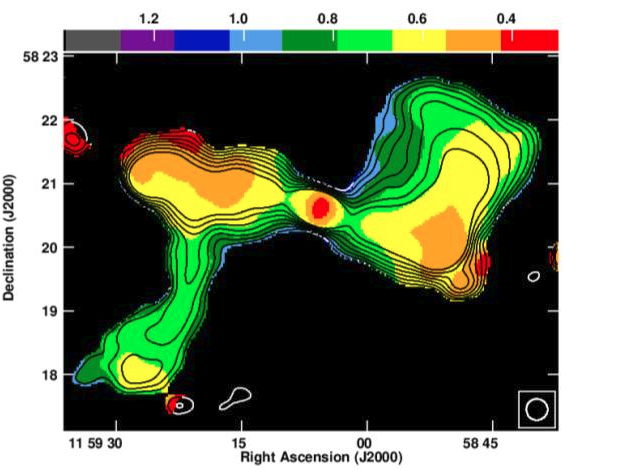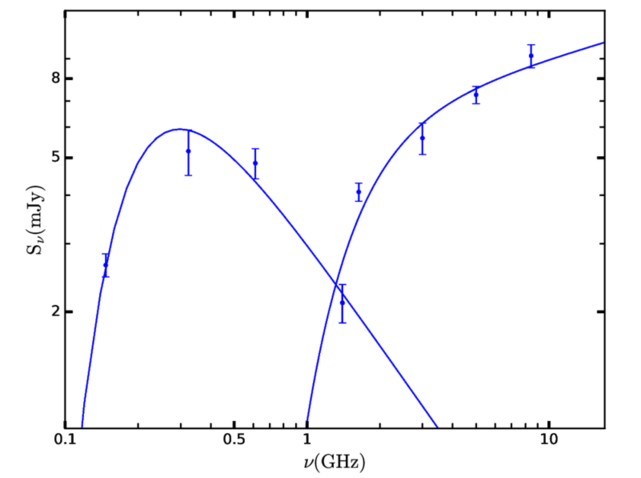Astronomy Object of the Month: 2023, August
< previous Archive next >
Reorientation of jets as a result of collision of galaxies
This Astronomical Object of the Month describes the study of the X-shaped radio galaxy J1159+5820. The authors explain that the reason for this strange structure may be the specific behavior of the supermassive black hole interacting with its disturbed environment during the merger of galaxies that formed the host galaxy CGCG292-057.

Illustration 1: Radio map of the vast object J1159+5820 at 147 MHz frequency coming from the GMRT interferometer (pink) superimposed on the optical image (white). In the enlargement in the right part of the figure, radio contours (red) at the frequency of 5 GHz (data from the VLA) coming from the central structures of the object: the nucleus and inner lobes are visible. The contours are superimposed on an optical image of the distorted host galaxy CGCG292-057. Source: original publication.
In galaxies whose central supermassive black holes devour huge amounts of matter, relativistic outflows of particles called radio jets can be generated. These outflows are usually axisymmetric and collimated over lengths from several kpc to several Mpc. They can emanate for tens of millions of years and during that time form vast structures called radio galaxies. However, there are objects whose radio images have bent X- or S-shaped forms. Such a strange structure may be a manifestation of the dynamic motion and interaction of the central supermassive black hole with its surroundings, or be the result of intense interaction of jets with the interstellar and intergalactic medium. The reason for this behavior of the black hole and its surroundings may lie in the violent merger of two galaxies, still visible in the optical image of the examined object.
Galactic collisions are excellent laboratories for studying the evolution of galaxies in different cosmological epochs. Collisions provide galaxies with fresh supply of gas and dust that can initiate the activity of central active nuclei (so-called AGNs) associated with supermassive black holes. If there are additionally relativistic outflows (jets) in such objects, they can lead to the formation of non-standard extensive radio structures. This is clearly seen in the case of 3C321, where one of its jets is bent by interaction with a nearby, merging galaxy. During collisions, the "work" of the central AGN is disrupted, so studying the radio jets associated with such galaxies can be a great probe to understand the behavior of the central supermassive black hole.
Recently, astronomers have carefully studied the radio galaxy J1159+5820. It has an unusual X-shaped radio structure. In addition, in its center there is a compact nucleus and a pair of young radio mini-lobes. Studying the radio spectrum of the nucleus (see Figure 3), scientists discovered its unusual shape. The synchrotron radiation at low frequencies is effectively absorbed by the ionized dense interstellar medium. The image of the host galaxy CGCG292-057 on optical map shows prominent tidal filaments and a series of arc-shaped shells that are remnants of the collision.
In order to understand the properties of the plasma inside the extensive structure and its evolution over time, an analysis of the radio spectrum at various locations of the radio source was conducted. The results led astronomers to conclude that the X-shaped morphology is the result of several million years of reorientation of the jets. The inhomogeneities at the center of the parent galaxy, that is left over from the galaxy collision, are most likely responsible for the jet precession causing the X-shape appearance of the radio galaxy. Further detailed studies of this object and other merging galaxies that are also luminous in radio will provide information on the structure and processes taking place in the region surrounding the central supermassive black holes.

Figure 2: Map of the spectral index between the frequencies 144 MHz (LOFAR) and 5 GHz (VLA). The scale at the top of the figure indicates areas with flat (lower values) and steep (higher values) spectral index, which correspond, respectively, to the less and more energetic particles generating the observed synchrotron radiation. Source: original publication.
 Figure 3: The complex shape of the radio spectrum of the central nucleus with model curves describing its physical parameters, i.e. the size and density of the surrounding medium. Source: original publication.
Figure 3: The complex shape of the radio spectrum of the central nucleus with model curves describing its physical parameters, i.e. the size and density of the surrounding medium. Source: original publication.
Original publication: Misra A., Jamrozy M., Weżgowiec M., Multifrequency analysis of the radio emission from a post-merger galaxy CGCG 292-057, Monthly Notices of the Royal Astronomical Society, 523, 2, 1648 (2023)
The research was conducted at the Department of Stellar and Extragalactic Astronomy of the Jagiellonian University’s Astronomical Observatory (OA UJ). The work was carried out thanks to the financial support of the National Science Center through grant UMO-2018/29/B/ST9/01793 and Jagiellonian University through grant N17/MNS/000055.
Contact:
 Figure 3: The complex shape of the radio spectrum of the central nucleus with model curves describing its physical parameters, i.e. the size and density of the surrounding medium. Source: original publication.
Figure 3: The complex shape of the radio spectrum of the central nucleus with model curves describing its physical parameters, i.e. the size and density of the surrounding medium. Source: original publication.
Original publication: Misra A., Jamrozy M., Weżgowiec M., Multifrequency analysis of the radio emission from a post-merger galaxy CGCG 292-057, Monthly Notices of the Royal Astronomical Society, 523, 2, 1648 (2023)
The research was conducted at the Department of Stellar and Extragalactic Astronomy of the Jagiellonian University’s Astronomical Observatory (OA UJ). The work was carried out thanks to the financial support of the National Science Center through grant UMO-2018/29/B/ST9/01793 and Jagiellonian University through grant N17/MNS/000055.
|
Arpita Misra Astronomical Observatory Jagiellonian University amisra[@]oa.uj.edu.pl |


